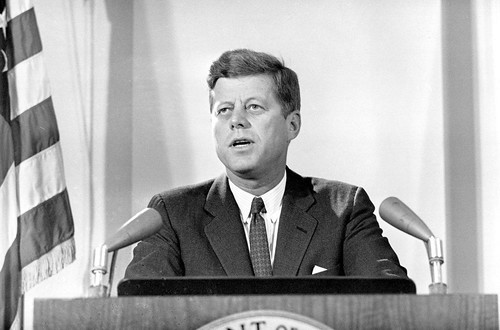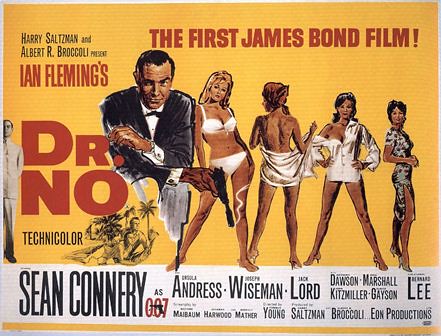An appeals court orders the University of Mississippi to admit James Meredith, the first African-American student admitted to the segregated university.
Tag Archives: 1962
6 September 1962
Archaeologist Peter Marsden discovers the first of the Blackfriars Ships dating back to the second century AD in the Blackfriars area of the banks of the River Thames in London.
10 July 1962
Telstar, the world’s first communications satellite, is launched into orbit.
2 June 1962
During the FIFA World Cup, police had to intervene multiple times in fights between Chilean and Italian players in one of the most violent games in football history.
12 September 1962
President Kennedy delivers his “We choose to go to the Moon” speech at Rice University.
[rdp-wiki-embed url=’https://en.wikipedia.org/wiki/We_choose_to_go_to_the_Moon’]
2 February 1962
The United States bans all imports and exports from Cuba.
19 March 1962
The Algerian War of Independence ends.
The Secret Army Organization was founded in 1961 as a response to General De Gaulle’s speech on Algeria’s right to self determination. It was formed by a group of pied noirs that called themselves “counter-terrorists” and had carried out attacks against the F.L.N since early in the war. By acts of sabotage and assassination in France and French Algerian territories, the O.A.S attempted to prevent Algerian Independence. On September 1961 the O.A.S attempted to assassinate De Gaulle but failed.
Despite the O.A.S attempts to stall and prevent Independence, Evian peace talks were held on March 7th between the F.L.N’s provisional government and De Gualle. The Evian Agreement was signed on March 18, 1962, and a cease fire was called on the 19th . It was also agreed Algeria would be able to vote for its future Independence on 1st of July.
Now desperate on saving “French Algeria”, the O.A.S reacted more violently than ever. The three months between the cease fire and the day of Independence the O.A.S unleashed a series of attacks. Their hope was that these attacks would to force the F.L.N to abandon cease fire therefore revoking any agreement between the F.L.N and the French government. In April they raided Muslim hospitals in Algiers, killing ten patients in their beds and wounding seven others. On the 3rd of May they filled a truck with explosives and killed 62 Muslims and wounded 110. On May 10th thirty Muslim women were killed in the streets of Oran and Algiers. Other actions included blowing up part of the library of the University of Algiers and the assassination of a famous Berber writer. Despite the O.A.S’s violent provocations, the F.L.N did not retaliate and kept the cease fire agreement. In June 1962 a cease fire was agreed between the O.A.S and the F.L.N.
20 November 1962
The Cuban Missile Crisis ends.
President Kennedy called on Premier Khrushchev tonight to carry out his promised missile pullback “at once” so that the U.S. and Russia could move promptly “to the settlement of the Cuban crisis.”
Officials disclosed that the U.S. would insist on a time line in the UN negotiations on pullout details. Informed sources said it should be a “very, very short” period, a matter of days, because some of the missiles already are operational.
In a new letter to the Kremlin leader the President declared that he now believed he and Khrushchev had reached “firm” agreement on the terms for ending an ominous East-West clash that had carried the world to the brink of nuclear war.
In return for a speedy missile pullback in Cuba, under UN supervision, the President said the U.S. would lift the sea blockade and offer Russia assurances against a Cuban invasion.
“I hope that the necessary measures can at once be taken through the United Nations, as your message says,” Kennedy told Khrushchev, “so that the U.S. in turn will be able to remove the quarantine measures now in effect.”
In a separate gesture to smooth the path to a final settlement the President voiced “regret” that an American plane collecting fallout samples in the atmosphere had slipped into Soviet air space in far northeast Siberia. He promised that “every precaution” would be taken to prevent a recurrence.
Kennedy’s letter was made public less than eight hours after the Moscow radio broadcast a Khrushchev letter agreeing to Kennedy’s missile pullout demands. It seemed to mark the beginning of the end of the fateful cold war collision.
Around the world the news brought a sigh of relief despite Administration attempts to ward off any premature victory statements.
Even Kennedy suggested in his letter that a solution was at hand. Underlining this was the fact that Kennedy spent the first afternoon away from his desk since the crisis erupted.
5 October 1962
The first James Bond movie, Dr. No, is released.
Dr. No is a 1962 British spy film, starring Sean Connery, with Ursula Andress and Joseph Wiseman, filmed in Jamaica and England. It is the first James Bond film. Based on the 1958 novel of the same name by Ian Fleming, it was adapted by Richard Maibaum, Johanna Harwood, and Berkely Mather and was directed by Terence Young. The film was produced by Harry Saltzman and Albert R. Broccoli, a partnership that would continue until 1975.
In the film, James Bond is sent to Jamaica to investigate the disappearance of a fellow British agent. The trail leads him to the underground base of Dr. No, who is plotting to disrupt an early American space launch with a radio beam weapon. Although the first of the Bond books to be made into a film, Dr. No was not the first of Fleming’s novels, Casino Royale being the debut for the character; the film makes a few references to threads from earlier books. This film also introduced the criminal organisation SPECTRE, which would also appear in six subsequent films.
Produced on a low budget, Dr. No was a financial success. While critical reaction was mixed upon release, over time the film has gained a reputation as one of the series’ best instalments. The film was the first of a successful series of 24 Bond films. Dr. No also launched a genre of “secret agent” films that flourished in the 1960s. The film also spawned a spin-off comic book and soundtrack album as part of its promotion and marketing.
21 April 1962
The Seattle World’s Fair opens.
 The Century 21 Exposition – also known as the Seattle World’s Fair – was held between April 21 and October 21, 1962 drew almost 10 million visitors. A defining moment in the history of Seattle, this fair began life as the brainchild of City Councilman Al Rochester. By 1955, the councilman had generated considerable interest in his idea from decision makers at the state and city level, and in January Washington’s legislature allocated $5,000 for a small commission to study the feasibility of such a fair. Public excitement, spurred on by effective advertisement, soon gave the project further momentum; in 1957 Seattle voters passed a $7.5 million Civic Center bond for possible fairground development, an amount which was then matched by the legislature.
The Century 21 Exposition – also known as the Seattle World’s Fair – was held between April 21 and October 21, 1962 drew almost 10 million visitors. A defining moment in the history of Seattle, this fair began life as the brainchild of City Councilman Al Rochester. By 1955, the councilman had generated considerable interest in his idea from decision makers at the state and city level, and in January Washington’s legislature allocated $5,000 for a small commission to study the feasibility of such a fair. Public excitement, spurred on by effective advertisement, soon gave the project further momentum; in 1957 Seattle voters passed a $7.5 million Civic Center bond for possible fairground development, an amount which was then matched by the legislature.
By April 1962, all that remained to be done was to open the doors to the public, which occurred during an extravagant opening ceremony on the 21st. Amidst 538 clanging bells, 2000 balloons, and 10 Air Force F-102 fighters swooping overhead, Exposition president Joseph Gandy officially opened Century 21 for business. For the next six months, visitors would be entertained not just by the many exhibits, but also by an array of musicians, orchestras, dance troupes, art collections, singers, comedians, and other various shows traveling through the fair during its run. Adding to the star-studded atmosphere was the presence of the ‘King of Rock and Roll,’ Elvis Presley, who arrived to shoot a film, It Happened at the World’s Fair. Indeed, a number of celebrities came to the Exposition as tourists, including Vice-President Lyndon Johnson, Walt Disney, and Prince Phillip of Great Britain. By the close of the fair on October 21, a total of 9,609,969 people officially visited, largely satisfying attendance goals.



